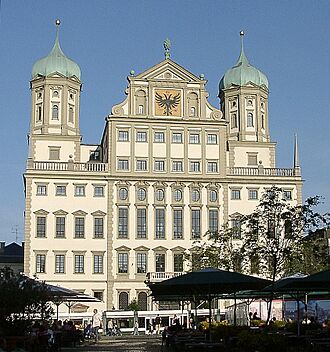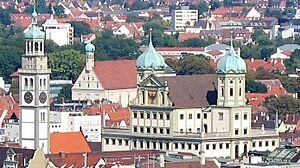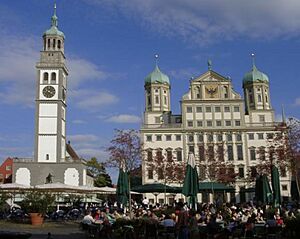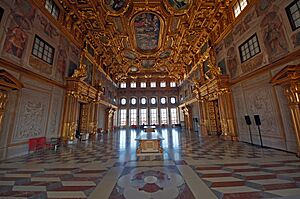Augsburg Town Hall facts for kids
Quick facts for kids Augsburg Town Hall |
|
|---|---|
|
Augsburger Rathaus
|
|
 |
|
| General information | |
| Type | Town hall |
| Architectural style | Renaissance |
| Location | Augsburg, Germany |
| Coordinates | 48°22′07″N 10°53′55″E / 48.3687°N 10.8987°E |
| Construction started | 1615 |
| Completed | 1624 |
| Renovated | 1980–1984 |
| Cost | 100,000 Guilder |
| Technical details | |
| Floor count | Seven |
| Design and construction | |
| Architect | Elias Holl |
The Augsburg Town Hall (German: Augsburger Rathaus) is a famous building in Augsburg, Bavaria, Germany. It is the main office for the city's government. This town hall is one of the most important buildings from the Renaissance period north of the Alps mountains.
A talented architect named Elias Holl designed and built it. He was the city's Stadtbaumeister, or Master Builder. Construction took place between 1615 and 1624. Because of its history and cultural value, the building is protected by an international agreement called the Hague Convention for the Protection of Cultural Property in the Event of Armed Conflict.
Contents
What Makes Augsburg Town Hall Special?
The foundation stone for the Town Hall was laid on August 25, 1615. Elias Holl, the city's master builder, oversaw the project. The outside of the building was finished by March 1620. The inside was completed a few years later, in 1624.
This building was very advanced for its time. When it was finished, it was the first building in the world with more than six floors. Its strong, elegant stone design was similar to buildings in Florence, Italy. Florence was a major cultural and financial city. Augsburg, a Free Imperial City (meaning it was self-governing within the Holy Roman Empire), liked to compare itself to Florence.
The Town Hall shows Augsburg's pride in two special decorations on its front. One is the Reichsadler, or Imperial Eagle. This eagle was a symbol of the Holy Roman Empire. It showed how important Augsburg was. The other symbol is a large copper pine cone, called a Zirbelnuss. This pine cone is the official symbol of Augsburg.
For many years, another building blocked the view of the Town Hall. This was the stock exchange building, built in 1828. However, during World War II, British planes bombed Augsburg. The stock exchange building was destroyed on February 25, 1944. After the war, its remains were cleared away in the 1960s. This finally allowed people to see the beautiful Town Hall clearly from the main town square.
History of the Augsburg Town Hall
The first Augsburg Town Hall was built way back in 1385. In the early 1600s, the city council wanted to update it. They needed more space for the Imperial Reichstag, which was a very important meeting of leaders from the Holy Roman Empire.
In 1609, the city hired Elias Holl, a famous architect, to plan the renovation. Holl worked on the plans for six years. But when he showed them to the council, they said no! Instead, the mayor, Hieronymus Imhoff, had a new idea. He wanted to tear down the old Gothic town hall. In its place, he wanted a completely new and grand building.
Elias Holl then designed the new Augsburg Town Hall in the Renaissance style. The foundation stone was laid on August 25, 1615. The city leaders did not want towers on the building. But Elias Holl really wanted the famous onion domes on the gables. In 1618, he was allowed to add them. The outside of the Town Hall was finished in 1620. The inside was completed in 1624. The whole project took almost 15 years of planning and 9 years of building.
Inside the Town Hall, Holl designed three main halls. On the ground floor, past the main entrance, is the Lower Fletz. Above it, on the next floor, is the Upper Fletz. The most amazing room is the Goldener Saal, or Golden Hall. It is two stories tall and has amazing doorways, murals (wall paintings), and a special coffered ceiling. Next to the Golden Hall are the Fürstenzimmer, or Prince's Rooms. These were designed as private spaces for important guests. Building the new Town Hall cost about 100,000 Guilder.
The Thirty Years' War (1618–1648) started soon after the Town Hall construction began. This war affected all of Europe, including Augsburg. Before the war, Augsburg was a major economic center. But after the war, in the mid-1600s, the city was in decline. The war cost Augsburg its economic power and more than half of its population. The Reichstag, which the Town Hall was built for, started meeting in other German cities.
Only once more, in the late 1600s, was the Town Hall used for a big national event. In 1690, Joseph I held a banquet in the Golden Hall. This was after he was crowned King of the Romans.
During World War II, the Town Hall was badly damaged by bombs. The outside of the building was completely burned. After the war, the Town Hall was rebuilt. The outside looked like it did before, but the inside was much simpler. From 1955, it was used again as the city's government center.
Between 1980 and 1984, the outside of the building was restored to its original colors. These colors were found in old records. The Golden Hall, which was damaged in the war, was also restored to its original beauty. On January 9, 1985, the Town Hall officially reopened. This was part of the city's 2000th anniversary celebration.
Inside the Town Hall: Famous Rooms
Lower Fletz
Visitors enter the Augsburg Town Hall through a simple door at the front. This leads into a small entry area and then into the Lower Fletz. This large hall is on the ground floor. It has marble columns and a vaulted ceiling. It is the main entrance to two staircases that go up to the higher floors of the Town Hall.
Upper Fletz
The Upper Fletz is on the second floor. It used to hold the offices for the Augsburg city council. After the war, it became the main meeting room for the council. This floor also has offices for the different political groups on the council. This part of the Town Hall is usually not open to visitors.
Golden Hall
The Goldener Saal, or Golden Hall, is the most impressive room in the Town Hall. It is one of the most important cultural treasures from the late German Renaissance. The hall is very large, covering about 552 square meters (5,940 square feet). Its ceiling is about 14 meters (46 feet) high. It is beautifully decorated with grand doorways, amazing murals, and a coffered ceiling.
The inside of the hall was designed by Johann Matthias Kager. It was not finished until 1643, even though the rest of the building was done in 1624. The many paintings on the ceiling and walls were based on ideas from Matthäus Raders, a Jesuit, and designs by the Flemish artist Peter Candid.
The Golden Hall was badly damaged by bombs during the war. When the Town Hall was rebuilt, the Golden Hall was not fully repaired at first. It had a simple wooden ceiling, small doors, and plain white walls. It was used as an exhibition space until the 1980s.
In the early 1980s, the city council decided to restore the Golden Hall. This was for the city's 2000th anniversary in 1985. The room was redecorated using old drawings and photos. They rebuilt the coffered ceiling, painted the ceilings, and restored the floor and doors. On January 9, 1985, the hall reopened, looking almost as grand as before. With many donations and help from the people of Augsburg, the murals and gold decorations were added back over the next few years. The hall officially reopened a second time in 1996.
Fürstenzimmer
The Fürstenzimmer, or Prince's Rooms, are four rooms located around the Golden Hall. They were originally used as private spaces for important guests of the council. Each room is about 150 square meters (1,600 square feet). They have coffered ceilings, wood-paneled walls, and parquet floors. They also have beautifully carved desks, tables, chairs, and lamps. These rooms were also badly damaged during the war. So far, only one has been fully restored. Work is still continuing on the others.
Augsburg Town Hall Today
Today, the Augsburg Town Hall has exhibits about the history of the city. It also features displays about its partner cities. There are often new exhibitions on different historical and current topics. These are held in the Lower Fletz and are open to everyone.
The Golden Hall is a popular place for parties, concerts, and special events. Both the Lower Fletz and the Golden Hall are open daily. There is a small fee to enter the Golden Hall. The basement of the Town Hall has a traditional German restaurant called a Rathskeller.
See Also
- History of early modern period domes





